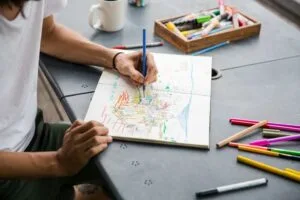In an era where digital solutions are increasingly prevalent in healthcare, virtual art therapy emerges as a transformative approach to mental health treatment. This innovative modality combines the creative process of art-making with digital technology, offering therapeutic benefits through a virtual platform. As we delve into virtual art therapy, we explore its mechanisms, benefits, and how it stands as a beacon of hope for individuals.
Contents
Can Art Therapy Be Done Virtually?
 Art therapy traditionally involves using creative methods like drawing, painting, or sculpting to help people express themselves and manage their emotions and stress. It’s a therapy approach that combines art-making with psychological treatment. Thus, providing a unique way for individuals to explore their feelings, reconcile emotional conflicts, and boost self-awareness.
Art therapy traditionally involves using creative methods like drawing, painting, or sculpting to help people express themselves and manage their emotions and stress. It’s a therapy approach that combines art-making with psychological treatment. Thus, providing a unique way for individuals to explore their feelings, reconcile emotional conflicts, and boost self-awareness.
Thanks to modern technology, art therapy can indeed be done virtually. This means that instead of being in the same room with a therapist, participants can engage in art therapy sessions via digital platforms like video calls. It allows individuals to create art at home while interacting with a therapist online. Hence, making it a practical and accessible option for those who prefer to remain remote due to convenience.
How Does Virtual Art Therapy Work?
Virtual art therapy works by blending traditional art therapy techniques with the convenience of digital communication platforms. Here’s a closer look at how it typically operates:
1. Setup and Equipment
Participants need basic art supplies like paper, paints, or clay, along with a computer or tablet equipped with a camera and internet connectivity. The specific materials can vary based on the art projects planned by the therapist.
2. Digital Platform
Therapy sessions are conducted through video conferencing tools where both the therapist and the participant can see and interact with each other in real time. Platforms used may include common video call applications like Zoom, Skype, or specialized telehealth services that ensure privacy and confidentiality.
During these sessions, the therapist guides the participant through various art-making processes aimed at exploring emotions, addressing unresolved issues, and fostering personal growth.
The art created becomes a medium through which individuals can express thoughts and feelings that might be hard to articulate with words alone. So, this method allows for a therapeutic dialogue between the therapist and the client about the artwork and the emotions or memories it might represent.
What Are The Techniques Used in Virtual Art Therapy?
 In virtual art therapy, several creative techniques are employed to help clients express themselves and work through their emotions. These techniques are adaptable to the virtual environment and can be easily facilitated through digital communication platforms. Here are some of the common techniques used:
In virtual art therapy, several creative techniques are employed to help clients express themselves and work through their emotions. These techniques are adaptable to the virtual environment and can be easily facilitated through digital communication platforms. Here are some of the common techniques used:
- Drawing and Painting
These are the most straightforward techniques, where clients use pencils, crayons, markers, or paint to create images. Hence, the therapist might give specific prompts or themes. And, allow the client to freely create whatever comes to mind.
- Collage
Clients can create digital or physical collages using cut-outs from magazines, photographs, or digital images. This technique helps in exploring feelings and thoughts by piecing together various elements to form a cohesive whole.
- Sculpture
Using materials like clay or playdough, clients can build three-dimensional projects. In a virtual setting, the therapist observes and discusses the client’s process and creations via video.
- Photography
Clients can use photography to capture emotions or tell stories through the lens. They might be tasked with photographing certain objects, scenes, or themes that resonate with personal experiences or feelings.
- Digital Art
Utilizing graphic tablets or art apps, clients can draw, paint, or design artwork digitally. So, this is especially effective in virtual settings as it seamlessly integrates with the technology used for therapy sessions.
- Art Journaling
Combining drawing or painting with writing, art journaling allows clients to document their thoughts, feelings, and experiences creatively. This can be particularly therapeutic and provides a tangible way for clients and therapists to track progress and reflect on therapy sessions.
- Mindfulness and Art
Integrating mindfulness techniques with art-making, clients focus on the present moment while engaging in the creative process. This can be a calming and centering practice that enhances emotional regulation.
Thus, these techniques in virtual art therapy allow therapists to tailor sessions to each client’s needs and preferences. Hence, making therapy accessible and engaging, even from a distance.
What Are The Benefits And Limitations to Consider?
The following are some common benefits and limitations of virtual art therapy:
Benefits
- Accessibility: Virtual art therapy is more accessible to people who may have mobility issues, live in remote areas, or have busy schedules that make it difficult to attend in-person sessions. It allows anyone with internet access to benefit from art therapy.
- Convenience: Sessions can be attended from the comfort of one’s own home. And, removing the need for travel and making it easier to fit therapy into regular schedules.
- Comfort: Being in a familiar environment can make clients feel more at ease. Potentially leading to more openness and effectiveness in therapy.
- Anonymity and Privacy: Some individuals might feel more comfortable sharing sensitive or personal information from the privacy of their home rather than a therapist’s office.
- Innovation: The use of digital tools and software can introduce new forms of art-making and expression that might not be possible with traditional materials.
Limitations
- Technology Issues: Dependence on technology means that sessions can be affected by technical issues like poor internet connectivity, hardware problems, or software glitches.
- Less Hands-On Guidance: The therapist cannot physically assist with art-making or observe as closely as they might in person. This can sometimes limit their ability to provide immediate feedback or adjust techniques.
- Privacy Concerns: While digital platforms can offer convenience, there is also the risk of breaches in confidentiality if secure platforms are not used.
- Therapeutic Boundaries: The virtual environment might make it harder to establish and maintain the professional boundaries typically set in a physical therapist’s office.
- Limited Interaction: The depth of interaction can be less in a virtual setup, where non-verbal cues such as body language are harder to perceive. Potentially affecting the therapist’s ability to fully understand the client’s emotions.
Thus, understanding these benefits and limitations can help both therapists and clients manage expectations and create a more effective therapeutic environment. Hence, making virtual art therapy a viable option for those seeking mental health support.
How Much Does Virtual Art Therapy Cost?
 The cost of virtual art therapy can vary widely depending on several factors, such as the therapist’s qualifications, the session length, and the geographical location. Generally, virtual sessions might be slightly less expensive than in-person visits because therapists often have lower overhead costs when working online.
The cost of virtual art therapy can vary widely depending on several factors, such as the therapist’s qualifications, the session length, and the geographical location. Generally, virtual sessions might be slightly less expensive than in-person visits because therapists often have lower overhead costs when working online.
Prices can range from around $50 to $150 per session. Some therapists offer sliding scale fees based on the client’s income. So, this can make therapy more affordable for those with lower incomes. Additionally, it’s worth checking if your health insurance plan covers virtual art therapy. Hence, this can significantly reduce the cost.
Conclusion
Virtual art therapy merges the healing power of art with the convenience of modern technology, providing a flexible and accessible form of mental health support. Whether drawing, painting, or using digital tools, this approach allows individuals to explore their emotions and experiences from the comfort of their own homes. While it comes with its set of challenges, the benefits of increased accessibility, comfort, and privacy often outweigh these limitations.
For more information, please contact MantraCare. Online therapy types include videoconferencing, phone sessions, messaging-based therapy, chat-based therapy, and therapy based on different problems. If you have any queries regarding Online Counseling experienced therapists at MantraCare can help: Book a trial therapy session


